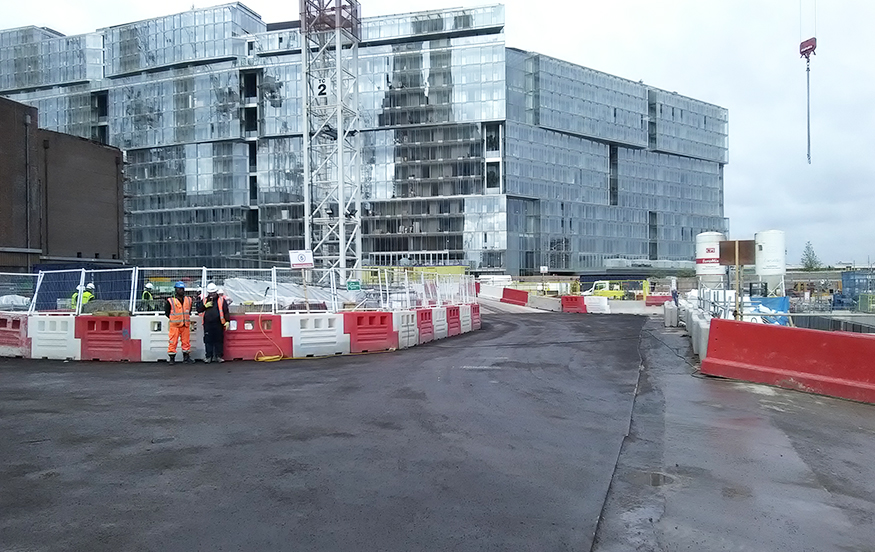Battersea Power Station Redevelopment: When is a Roof not a Roof, When it is a Road? By the Mastic Asphalt Council (MAC)
As part of a seven phased, £8bn redevelopment project, Battersea Power Station is currently being transformed into one of the largest and most eagerly anticipated mixed-use developments in the world.
The Power Station was fully decommissioned in 1983 and given Grade II* building status. Located opposite Chelsea, about a mile from the Houses of Parliament, the scale of Battersea Power Station is monumental. The overall site covers an area of 42 acres, of which 18 acres will be public space with a new six acre riverfront park and a new Zone 1 London Underground station. It opens up a stretch of the Thames that has been sealed off to the public for over a century. Along with more than 4,000 new homes, half the development will comprise commercial space for offices, restaurants and shops.
Part of the development involves the creation of a new high street known as The Electric Boulevard which will serve as the main gateway to the entire Battersea development area by connecting it with the Northern Line Extension station. It will also feature one of Europe’s largest roof terraces known as Battersea Roof Gardens. The project is being carried out by Battersea Power Station Development Company and is expected to continue until 2025.
The overall success of the project will depend on each element of the programme being completed to deadline and to the highest specification. A mastic asphalt system was specified to provide effective long-term protection to the waterproofing installed to the haul roads at the Battersea Project. BriggsAmasco – a member of the Mastic Asphalt Council – designed, supplied and installed a 40mm mastic asphalt surface without hindrance to other on-site trades. The system chosen was based on a mastic asphalt system which is typically used for the protection of roofs.
The waterproofing needed to be installed early to allow the installation of the energy centre below podium level, however it was determined pre-contract that the waterproofing would not be able to withstand the high traffic loads that would transit the podium during construction. Various protection methods were reviewed and mastic asphalt was the only product that would be able to withstand continued use of artic lorries and mobile cranes over the surface for a period of 2-3 years without pulling up and damaging the protection and importantly the waterproofing.
Rapid application and quick curing times were critical on this 24/7 project, as the haul roads needed to be closed out of hours but re-opened for use within just three hours of laying. The fast installation and cool time of mastic asphalt proved a major benefit, along with BriggsAmasco’s successful implementation of a works schedule drawn-up in conjunction with other trades.
Weight was a further consideration that needed to be taken into account. A hot rolled tarmac product would have to be three times as thick to withstand the traffic loads and would have to be removed post-use due to the excessive weight on the podium. There were also concerns that frost heave could have occurred with hot rolled tarmac. By comparison, mastic asphalt is void-less so this problem does not occur.
A specific anti-slip finish was developed that could bond to the surface and enhance the indentation resistance, providing the highest level of grip normally associated with trunk roads. Due to the long-term weight limits allowed on the podium, slab accuracy was paramount.
BriggsAmasco used a state-of-the-art asphalt finisher to provide a precise finish and depth of product, as hand laid asphalt methods could have had a tolerance of +/-7mm. It has been estimated that the asphalt finishing machine can operate up to five times faster than traditional hand laid methods, thus saving time, money and waste. On this project, it would have been possible to lay 36 tonnes of product per day if the mastic asphalt system had been laid by hand, however using the finisher allowed production to double to 72 tonnes per day, without any additional manual labour from trained installation crews.
Due to the landscaping finishes, some of the mastic asphalt will have to be removed at the end of the project, but this will be easily undertaken using road planers. At the end of its useful life, mastic asphalt can be recycled or used as roof screed, so if required, it can be used on another project.
As BriggsAmasco have used the asphalt finisher and are aware of the precise thickness of the asphalt system, a computer controlled planer will be used to remove 30mm from the protection, leaving the waterproofing intact and functioning for the lifetime of the structure.
Although not a ‘headline’ aspect of the redevelopment of Battersea Power Station, the successful implementation of the access road was absolutely crucial in ensuring works continued to schedule and in safety. Mastic asphalt, in the hands of BriggsAmasco, proved itself the reliable, go-to material for a project that is transforming a much loved, near 100 year old architectural landmark into an awe-inspiring 21stcentury social, commercial and domestic hub.
This article featured in the August Edition of RCi magazine – click here to take a look.

